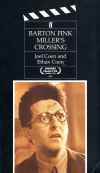 This book collects two screenplays by the Coen brothers. I haven’t seen either of the films, although I have seen one or more of their films (answerable by the question “Have you ever seen a movie with John Turturro and John Goodman?”) (Additional parenthetical: I saw O Brother, Where Art Thou?.)
This book collects two screenplays by the Coen brothers. I haven’t seen either of the films, although I have seen one or more of their films (answerable by the question “Have you ever seen a movie with John Turturro and John Goodman?”) (Additional parenthetical: I saw O Brother, Where Art Thou?.)
The book starts out with a film editor who did not have a good relationship with the brothers and ended up getting removed from a couple of their films. I’m not sure what it adds, but there it is.
Barton Fink is the story of a playwright from New York whose first Broadway success draws attention from Hollywood, where a studio lures him out to work under contract writing a B-picture about wrestling. Fink has to adjust to life in California and the pressures of writing something unnatural to him. He befriends the secretary of another writer drawn to Hollywood like himself and an insurance agent that resides in the hotel with him. Suddenly, there are bodies and shooting. Rather abruptly. Then it ends. Not a very satisfying thing to read, and I admit I sometimes confused Barton Fink with Ed Wood, which I’ve also never seen. But now that I’ve read one of the two, that problem is solved.
Miller’s Crossing is more straight-through with its themes. It’s a mob picture, with the lackey of one crime lord playing angles to try to prevent a mob war and to make time with the crime lord’s moll, either protecting or giving up her brother to another crime lord who wants him killed for chiseling. There are crosses, double-crosses, frame-ups, cover-ups, and a bunch of other stuff in it. It works better all the way through than Barton Fink, mainly because we’re not given a story about the problems of mobbing and then a climax about how hard it is to write a movie.
As I mentioned, these are screenplays, which is so much different from reading a play. The last screenplay I read was for Casablanca, way before this blog existed, and I don’t remember it being as complex in descriptions of shots. It reminds me of what I read in David Mamet’s On Directing Film (at least I think it was from that book) about capturing individual shots and scenes–as the Coen brothers are writers and directors (and producers), they would write a bit more from that perspective. However, if it’s not your native argot, the visualization based on shot names, you might miss some of the stage direction.
A worthwhile read, and undoubtedly it’s a textbook in some film classes.
Books mentioned in this review:


